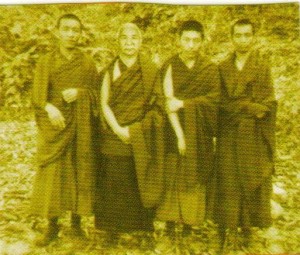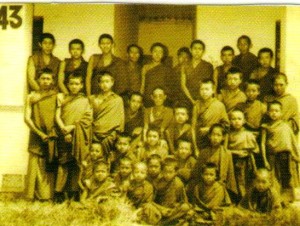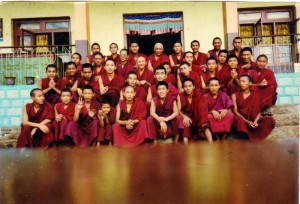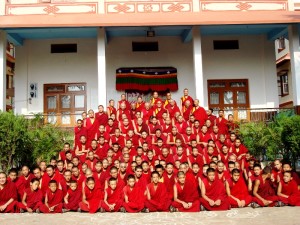A Brief History of Sera-Mey Tsangpa Khangtsen
History in Tibet
After the establishment of Gaden Monastery by rJe Tsongkhapa in the year 1409 AD, the Gelugpa School of Tibetan Buddhism came into existence. Gradually the direct disciples of Tsongkhapa established many centers of learning. They spread the teaching of Tsongkhapa.
Jamchen Choeje Shakya Yeshe, a direct disciple of Tsongkhapa, established Sera Theckchen Ling monastery in 1419 AD on the instructions of his teacher. Eventually many disciples from all parts of Tibet gathered in the monasteries for learning. They were provided the opportunity of learning and practicing the teaching. Gradually four Dratsangs (Colleges) were established. Up untill the Chinese invasion of Tibet in 1959, Sera Monastic University consisted of three colleges – Sera-Mey, Sera-Jey and Sera Ngagpa Dratsang (Tantric College).
Sera-Mey Thoesam Norling Dratsang was established in 1421 AD by Kunkhyen Jangchub Bumpa, a direct disciple of Tsongkhapa. He became the head of the Dratsang (Monastic College) and the teacher. With the passage of time, students from all parts of Tibet started pouring into the monastery, which led to the establishment of separate houses to accommodate the burgeoning number of students. During this process, Tsangpa Khangtsen (House) was established to accommodate the students coming from Tsang and Tod province of Tibet, which is one of the sixteen houses of Sera Mey Monastic College.
Tsangpa Khangtsen has produced many scholars and practitioners who have worked for the development of the teachings and benefit of all beings. Among them was the Tsangpa Yungton Choeje or Yungton Tsundue Zangpo, the 2nd abbot of the monastery and four other abbots who were known for their contributions.
Due to the prayers and blessings of these scholars and holy beings, there were five hundred monk students in this house before the Chinese occupation in 1959. However, due to the lack of residential facilities only three hundred monk students could be accommodated in this house.
History in Exile
In 1959 the Chinese took total control over Tibet. This was the beginning of the systematic destruction of thousands of monasteries and the killing of thousands of Tibetans by the Chinese. It was also the beginning of the total eradication of Buddhist teachings from Tibet. In such circumstances, many Tibetans followed His Holiness the Dalai Lama to India to seek refuge in India. From among the five hundred monk scholars of Sera Mey Tsangpa Khangtsen, only fifteen were able to escape to India.
However, due to the harsh climate and unfavorable conditions in India, they could not stay together for want of better livelihood and facilities. Eventually, only five monks – Ven. Lobsang Palden, Geshe Losang Monlam, Geshe Gedun Gyaltsen, Geshe Tenzin Wangdak, better known as Gen Lhakpa la and Geshe Thupten Rinchen were able to stay together.
History of Buxa Dharma Settlement
With the great vision of His Holiness the Dalai Lama, a learning center was established for the monks of all the Tibetan Buddhist schools in Buxa, West Bengal in 1959. This center was established with the aim to provide opportunities to the monks from Tibet to continue their study on the five great sciences of Buddhism, and to preserve the great traditions of Tibetan culture and learning as well. From among these five monks, Ven. Lobsang Palden left them upon the instructions of the Tibetan government to train teachers for the new schools for Tibetan children in India. Thus, only four monks of this house managed to remain together.
Establishment of the Foundation of Teaching in Mysore Settlement
By the grace of His Holiness the Dalai Lama and the great support from the people and the Government of India, the newly arrived Tibetan refugees were provided lands for farming, houses and schools for the children in various settlement camps all over India.
In December 1969, as per the instructions of His Holiness and the able guidance of the Tibetan administration and with the great support from the Govt. of India, Sera Monastic University was shifted to Mysore in southern India. The Govt. of India had provided tents to accommodate the monks in which they lived for three years.
During that period, the monks of this monastic university worked hard to make this present campus comfortabel by clearing the forest, farming the land and landscaping the surroundings. Simultaneously, they continued their study of the scriptures and preserved the tradition of holding prayer festivals and ritual activities etc.
During this difficult period of rebuilding, the four monks of this house, cherishing the advice of His Holisness and the Abbot of the monastery, initiated a program to admit new monk students into the house with the sole objective to preserve the Buddha’s teaching and to hand over the precious culture and tradition of Tibet to new generation. The existence of the teachings is wholly dependent upon the existence of the monk community.
Keeping this is mind, these four monks of the house went door to door to get young children to join Tsangpa Khangtsen with the condition that they will take full responsibility of the child for their education and livelihood.
In 1970 they were able to get consent of twenty two children that they admitted to Sera-Mey Dratsang and Sera Mey Tsangpa Khangtsen with the audience of the abbot Khenrinpoche Ngawang Theckchok. In this way, the foundation of Sera Mey Tsangpa Khangtsen was laid down in the Arya Desh, India.
The Present State
With the hard work and selfless dedication of these four monks, Tsangpa Khangtsen now accommodates more than 170 monks. Among them, thirty eight students have graduated as Geshes and twenty as Geshe Lharampas – the degree provided by the Gelukpa School to scholars who pass with the highest distinctions.
At present we have Geshe Thupten Rinchen, who is one of the most celebrated living scholars of the Gelukpa School. One of our Geshes of Tsangpa Khangtsen is the abbot of Rekon Monastery, Switzerland and one of the monks is serving as the translator to the His Holiness the Dalai Lama. One of our Geshe is serving as the President of Geden Educational Association in Nepal. A few other Geshes of this house are working to establish new courses of imparting Buddhist scriptures in some monasteries as well as shouldering the responsibility teach Buddhism, and preserve the precious culture and traditions of Tibet.
Eighteen monks of this house are going to graduate as Geshe Lharampa in the near future and eighty monks are in various stages of their monastic education. Thirty eight monk students are attending the primary school for both the traditional and modern education.




